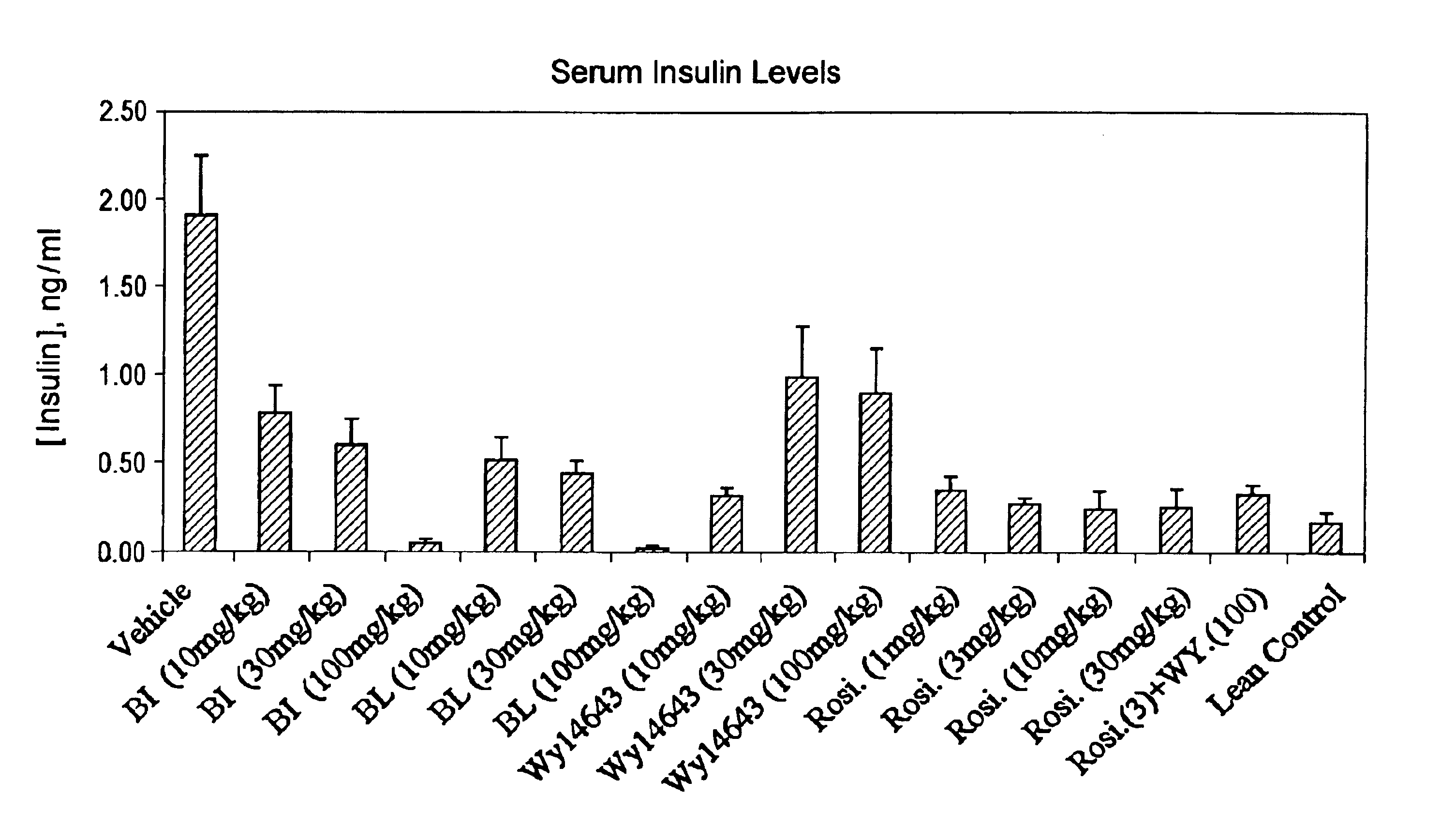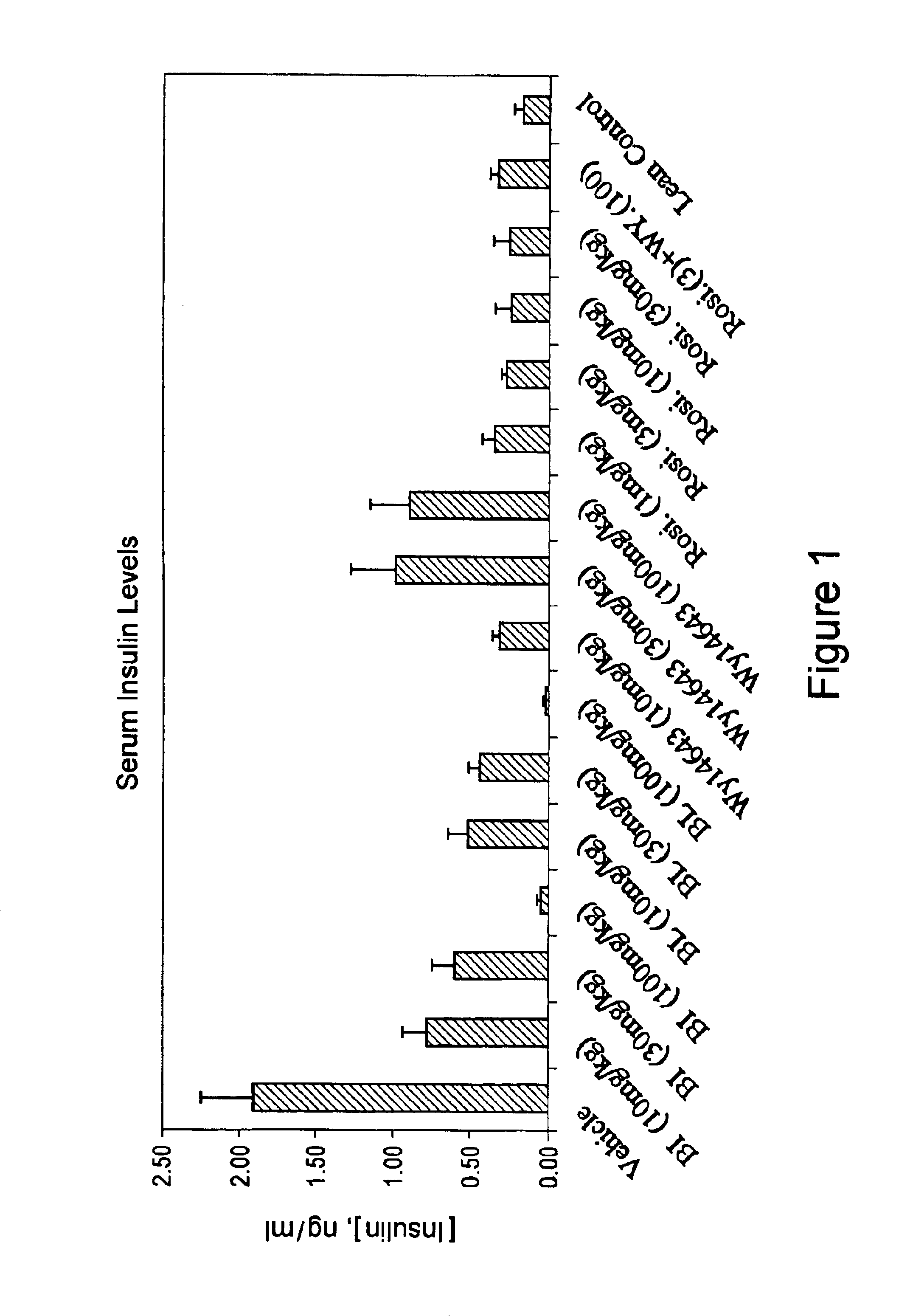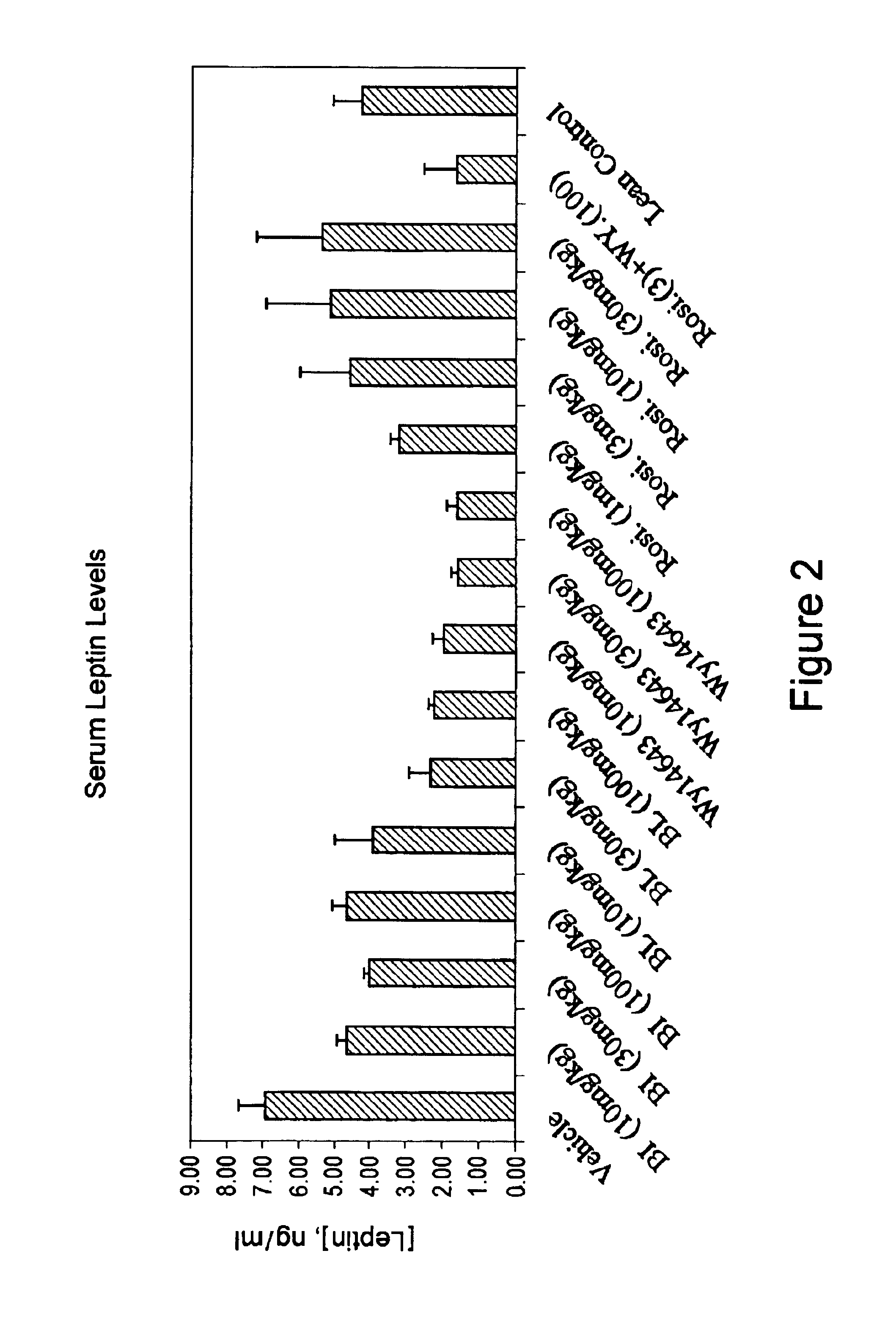Compounds for the treatment of metabolic disorders
a metabolic disorder and compound technology, applied in the field of compound therapy for metabolic disorders, can solve the problems of diabetes mellitus being a major cause of morbidity and mortality, debilitating complications, and prone to coronary artery diseas
- Summary
- Abstract
- Description
- Claims
- Application Information
AI Technical Summary
Benefits of technology
Problems solved by technology
Method used
Image
Examples
synthesis examples
CHEMICAL SYNTHESIS EXAMPLES
EXAMPLE 1
Synthesis of 4-(4-(2-Fluorobenzyloxy)Phenyl)-4-Oxobutyric Acid
Step A: Preparation of 4-(2-Fluorobenzyloxy)acetophenone:
A solution of 4-Hydroxyacetophenone (2.80 g, 20.6 mmol) in dry DMF (15 ml) was added at room temperature to a suspension of NaH (60% in oil, 0.794 g) in dry DMF (20 ml). When evolution of hydrogen ceased, 2-Fluorobenzyl bromide (3 g, 15.8 mmol) was added drop wise. The reaction mixture was stirred at room temperature for 6 hours, quenched with sat aq. NH4Cl and concentrated in vacuo. The crude residue was taken in EtOAc and washed with water and brine. The organic layer was dried over Na2SO4, filtered and concentrated. The residue was purified by flash chromatography on silica gel column (hex: ethyl acetate, 2:1) to provide the title compound as an off white solid.
1H NMR (270 MHz, CDCl3); 2.5 (s, 3H); 5.2 (s, 2H); 6.9-7.1 (m, 4H); 7.2-7.3 (m, 1H); 7.4 (t, 1H); 7.9 (d, 2H).
Step B: Preparation of tert-Butyl 4-(4-(2-fluorobenzyloxy)p...
example 2
Synthesis of 4-(4-(2-Methoxybenzyloxy)Phenyl)-4-Oxobutyric Acid
Step A: Preparation of 4-(2-Methoxybenzyloxy)acetophenone:
A solution of 2-Methoxybenzyl alcohol (2.99 g, 21.7 mmol) in dry THF (5 ml) and dry DMF (5 ml) was added to a stirred solution of 4Hydroxyacetophenone (3.25 g, 23.8 mmol), triphenylphosphine (7.36 g, 28.0 mmol), and diethyl azodicarboxylate (4.51 g, 25.9 mmol) in dry THF (20 ml) at 5-10° C. The reaction mixture was stirred at 0° C. for 2 hours, warmed to room temperature and concentrated in vacuo. The residue was taken in EtOAc and washed twice with saturated NaHCO3. The organic layer was dried over Na2SO4, filtered, concentrated and purified by flash chromatography on a silica gel column (chloroform: methanol, 99:1) to provide the title compound as a white solid.
1H NMR (270 MHz, CDCl3): 2.5 (s, 3H); 3.9 (s, 3H); 5.2 (s, 2H); 6.9-7.1 (m, 4H); 7.3 (m, 1H); 7.4 (d, 1H); 7.9 (d, 2H).
Step B: Preparation of Ethyl 4-(4-(2-methoxybenzyloxy)phenyl)-4-oxobutyrate:
To a stir...
example 3
Synthesis of 3-[(4-(2-Fluorobenzyloxy)Phenyl)-Methylthio]Propionic Acid
Step A: Preparation of 4-Hydroxybenzyl bromide:
To a stirred solution of PBr3 (1.38 g, 5.0 mmol) in dry THF (2 ml) at −5° C. was added a solution of dry pyridine (0.201 ml) in dry THF (0.4 ml). A solution of 4-Hydroxybenzyl alcohol (1.89 g, 15.2 mmol) in dry THF (23 ml) was added drop wise to the reaction mixture. The reaction mixture was allowed to stand at room temperature for 18 hours, then diluted with THF and filtered through celite pad. The filtrate was evaporated, the resulting semisolid was redissolved in dry toluene (16 ml). The solution was maintained at −20° C. for 2 hours, and then filtered through celite pad to provide the title compound as a light yellow solution which was used without further purification.
Step B: Preparation of Ethyl 3-((4-hydroxyphenyl)-methylthio)propionate:
To a solution of NaH (60% dispersed in oil, 0.731 g, 21.7 mmol) in dry DMF (15 ml) was added Ethyl 3-mercaptopropionate (2.66...
PUM
| Property | Measurement | Unit |
|---|---|---|
| resistance | aaaaa | aaaaa |
| peripheral insulin resistance | aaaaa | aaaaa |
| weight | aaaaa | aaaaa |
Abstract
Description
Claims
Application Information
 Login to View More
Login to View More - R&D
- Intellectual Property
- Life Sciences
- Materials
- Tech Scout
- Unparalleled Data Quality
- Higher Quality Content
- 60% Fewer Hallucinations
Browse by: Latest US Patents, China's latest patents, Technical Efficacy Thesaurus, Application Domain, Technology Topic, Popular Technical Reports.
© 2025 PatSnap. All rights reserved.Legal|Privacy policy|Modern Slavery Act Transparency Statement|Sitemap|About US| Contact US: help@patsnap.com



